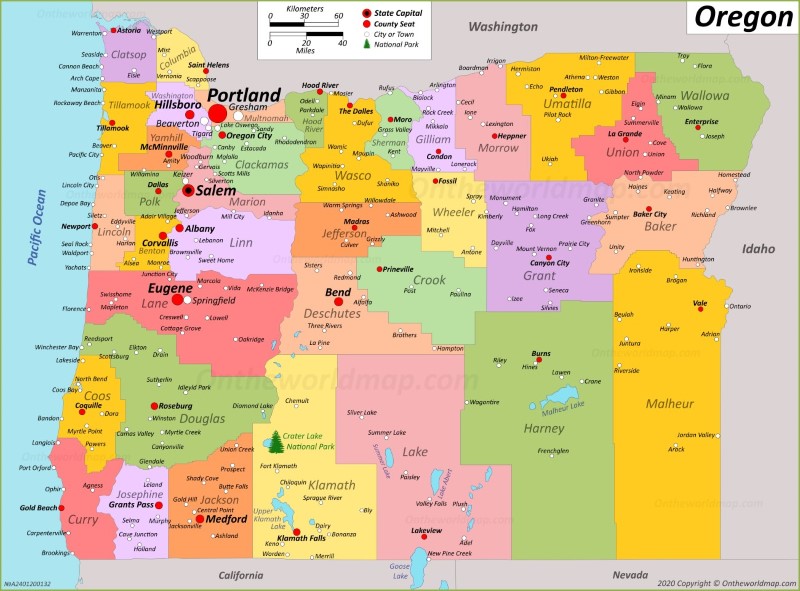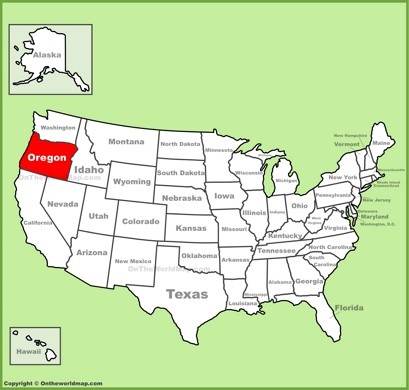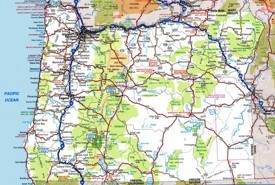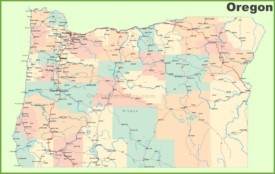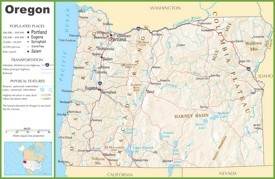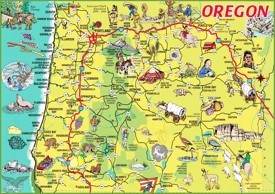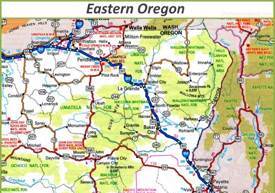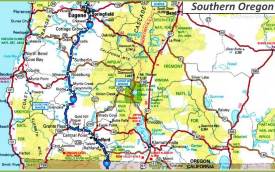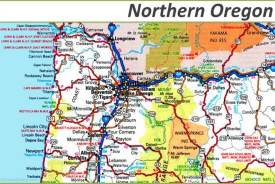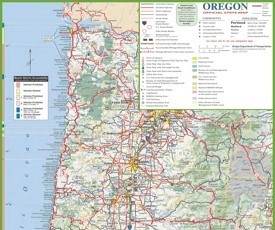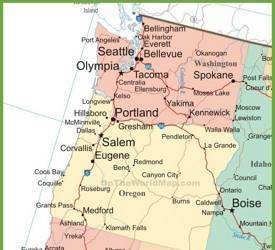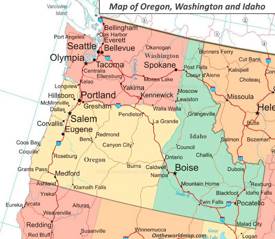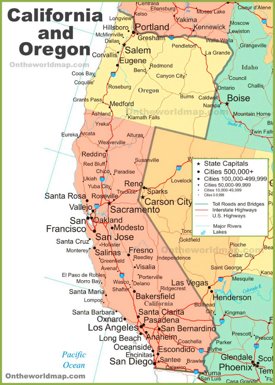Oregon Map
Description:
This map shows states boundaries, the state capital, counties, county seats, cities, towns, lakes and national parks in Oregon.
Size: 1300x961px / 283 Kb
Author: Ontheworldmap.com
You may download, print or use the above map for educational, personal and non-commercial purposes. Attribution is required. For any website, blog, scientific research or e-book, you must place a hyperlink (to this page) with an attribution next to the image used.
Page Navigation
Oregon Location Map
Online Map of Oregon
Detailed Maps of Oregon
Maps of Oregon Regions
Maps of Oregon and Neighbouring States
Other Maps of Oregon
Google Map of OregonOpenStreetMap
Bing Maps
USGS National Map
Oregon National Map (National Atlas of the United States)(pdf)
Official Oregon State Map (pdf)
About Oregon
Oregon, located in the Pacific Northwest of the United States, lies between Washington to the north, California to the south, Idaho to the east, Nevada to the southeast, and its western border is formed by the Pacific Ocean. Salem, situated in the agriculturally rich Willamette Valley, serves as the state capital.
Portland, Oregon’s largest city, has many cultural and economic activities, art culture, major parks, and big variety of cuisine. Eugene is home to the University of Oregon, contributes to the state's academic and economic landscape. Bend, strategically positioned near the Cascade Range, has emerged as a center for outdoor activities.
Tourism in Oregon benefits from its diverse landscapes, including coastal, forest, desert, and mountainous regions. Crater Lake National Park, with its deep and clear waters, ranks as a prominent natural attraction. The Oregon Coast, featuring scenic routes such as the Pacific Coast Scenic Byway, draws numerous visitors seeking coastal experiences. The Cascade Range, with Mount Hood, provides destinations for skiing, hiking, and recreational pursuits. The Columbia River Gorge facilitates windsurfing, hiking, and access to waterfalls.
The Facts:

Flag of Oregon |

Seal of Oregon |
| Capital: | Salem |
| Largest city: | Portland |
| Area: | 98,381 sq mi (254,806 sq km) |
| Dimensions: |
|
| Latitude: | 42° N to 46°18′ N |
| Longitude: | 116°28′ W to 124°38′ W |
| Population (2023): | 4,233,358[1] |
| Density: | 39.9/sq mi (15/sq km) |
| Elevation: | |
| Official language: |
|
| Religion (2022):[4] |
|
| Racial/ethnic groups (2020):[5] |
|
| Median household income (2021): | $71,562[6] |
| USPS abbreviation: | OR |
| ISO 3166 code: | US-OR |
| Time zone: |
|
| Official website: | www.oregon.gov |
List of The Largest Cities in Oregon by population
| Rank | City | County | Population (2023)[7] |
|---|---|---|---|
| 1 | Portland | Multnomah, Washington, Clackamas | 635,067 |
| 2 | Eugene | Lane | 177,923 |
| 3 | Salem | Marion, Polk | 177,487 |
| 4 | Gresham | Multnomah | 111,621 |
| 5 | Hillsboro | Washington | 107,299 |
| 6 | Bend | Deschutes | 103,254 |
| 7 | Beaverton | Washington | 97,053 |
| 8 | Medford | Jackson | 85,556 |
| 9 | Springfield | Lane | 61,400 |
| 10 | Corvallis | Benton | 60,956 |
| 11 | Albany | Linn, Benton | 56,472 |
| 12 | Tigard | Washington | 54,539 |
| 13 | Lake Oswego | Clackamas, Multnomah, Washington | 40,732 |
| 14 | Keizer | Marion | 39,376 |
| 15 | Grants Pass | Josephine | 39,189 |
| 16 | Oregon City | Clackamas | 37,572 |
| 17 | McMinnville | Yamhill | 34,319 |
| 18 | Redmond | Deschutes | 33,274 |
| 19 | Tualatin | Washington, Clackamas | 27,942 |
| 20 | West Linn | Clackamas | 27,373 |
| 21 | Wilsonville | Clackamas, Washington | 26,664 |
| 22 | Forest Grove | Washington | 26,225 |
| 23 | Woodburn | Marion | 26,013 |
| 24 | Newberg | Yamhill | 25,138 |
| 25 | Happy Valley | Clackamas | 23,733 |
Oregon Beach Towns
- Astoria
- Seaside
- Cannon Beach
- Newport
- Bandon
- Yachats
- Manzanita
- Rockaway Beach
- Gold Beach
- Seal Rock
- Lincoln City
- Otter Rock
- Depoe Bay
- Tierra Del Mar
- Beverly Beach
Main sights in Oregon
- Crater Lake National Park
- Columbia River Gorge National Scenic Area
- Hood River
- Washington Park
- Cannon Beach
- Mount Hood National Forest
- Hood River
- Astoria
- Smith Rock State Park
- Silver Falls State Park
- Depoe Bay
- Klamath Falls
- Oregon Dunes National Recreation Area
- Hells Canyon National Recreation Area
- Newberry National Volcanic Monument
Counties of Oregon
The state of Oregon, consists of 36 counties. Multnomah County, housing Portland, functions as Oregon's most populous and urbanized county. Marion County, where Salem, the state capital, is located, serves as a governmental and agricultural hub. Lane County, encompassing Eugene, plays a crucial role in education and industry. Deschutes County, with Bend as its center, attracts tourists with its outdoor recreational opportunities. Eastern counties, such as Malheur and Harney, cover vast rural areas and contribute significantly to agriculture and ranching. Coastal counties, including Clatsop and Coos, benefit from fishing, tourism, and forestry. Each county's distinct characteristics collectively enhance Oregon's diverse economic and geographical profile.
List of counties in OregonOregon County Map

Regions of Oregon:
- Applegate Valley
- Cascade Range
- Catlow Valley
- Central Oregon
- Columbia Plateau
- Columbia River Gorge
- Eagle Valley
- Eastern Oregon
- French Prairie
- Goose Lake Valley
- Harney Basin
- High Desert
- Hood River Valley
- Klamath Basin
- Mount Hood Corridor
- Northwest Oregon
- Oregon Coast
- Portland metropolitan area
- Rogue Valley
- Southeastern Oregon
- Southern Oregon
- Treasure Valley
- Trout Creek Mountains
- Tualatin Valley
- Umpqua Valley
- Wallowa Valley
- Warner Valley
- Western Oregon
- Willamette Valley
National Parks in Oregon
Crater Lake National ParkState Parks in Oregon
Geography of Oregon
Oregon's geography has a remarkable variety of landscapes, each contributing to its ecological and economic diversity. The Pacific Ocean forms the western boundary, featuring rugged cliffs, sandy beaches, and picturesque coastal towns. The Coast Range, running parallel to the ocean, consists of heavily forested hills and mountains.
To the east of the Coast Range lies the Willamette Valley, a fertile agricultural region that produces much of the state's fruit, vegetables, and wine. The Cascade Range, notable for its volcanic peaks like Mount Hood and Crater Lake, divides the state geographically and climatically. This mountain range offers significant recreational opportunities, including skiing and hiking.
Eastern Oregon features high desert landscapes, marked by plains, plateaus, and scattered mountain ranges such as the Blue and Wallowa Mountains. This region has a drier climate and supports agriculture, particularly cattle ranching and crop farming.
Major rivers, including the Columbia, Snake, and Willamette, provide critical water resources for irrigation, hydroelectric power, and recreation. Oregon’s diverse regions—coastal, valley, mountainous, and desert—create a tapestry of ecological zones, each with its unique environmental features and economic contributions.
Major Rivers in Oregon
- Columbia River
- Snake River
- Owyhee River
- Willamette River
- Crooked River
- D River
- Deschutes River
- Rogue River
- Williamson River
- Owyhee River
- Umpqua River
- Wallowa River
- Umpqua River
- Silvies River
- Burnt River
- Powder River
- Sprague River
- Siuslaw River
Lakes of Oregon
- Crater Lake
- Lake Abert
- Applegate Lake
- Lake Billy Chinook
- Bull Run Lake
- Siltcoos Lake
- Upper Klamath Lake
- Cleawox Lake
- Cullaby Lake
- Cultus Lake
- Diamond Lake
- Elk Lake
- Suttle Lake
- Strawberry Lake
- Fish Lake
- Goose Lake
- Malheur Lake
- Mann Lake
- Odell Lake
- Waldo Lake
- Mink Lake
Mountain Ranges
- Cascade Range
- Wallowa Mountains
- Steens Mountain
- Elkhorn Mountains
- Strawberry Range
- Pueblo Mountains
- Warner Mountains
- Gearhart Mountain
- Greenhorn Mountains
- Hart Mountain
- Paulina Mountains
- Klamath Mountains
- Oregon Coast Range
- Siskiyou Mountains
- Blue Mountains
The 15 highest mountain peaks of Oregon
- Mount Hood (11,249 ft / 3428.8 m)
- Mount Jefferson (10,502 ft / 3201 m)
- South Sister (10,363 ft / 3158.5 m)
- North Sister (10,090 ft / 3075 m)
- Middle Sister (10,052 ft / 3064 m)
- Sacajawea Peak (9,843 ft / 3000 m)
- Steens Mountain (9,738 ft / 2968 m)
- Aneroid Mountain (9,707 ft / 2958.7 m)
- Twin Peaks (9,678 ft / 2950 m)
- Eagle Cap (9,577 ft / 2919 m)
- Red Mountain (9,560 ft / 2913.8 m)
- Mount McLoughlin (9,499 ft / 2895 m)
- Elkhorn Peak (9,238 ft / 2816 m)
- Mount Thielsen (9,184 ft / 2799.4 m)
- Broken Top (9,180 ft / 2798 m)
Brief History of Oregon
The history of Oregon traces back to indigenous populations who inhabited the region for thousands of years before European exploration. In the late 18th century, explorers like Captain James Cook and the Lewis and Clark Expedition charted the area. The Oregon Trail, established in the mid-19th century, facilitated large-scale migration of settlers seeking fertile land.
Oregon Country, initially claimed by multiple nations, became an exclusive U.S. territory following the Oregon Treaty with Britain in 1846. Oregon achieved statehood on February 14, 1859, becoming the 33rd state. The state played roles in various historical events, including westward expansion and the timber industry's growth in the early 20th century.
Throughout the 20th century, Oregon evolved economically and culturally, balancing traditional industries like agriculture and forestry with technology and tourism sectors.
Page Navigation
References
1. ^ U.S. Census Bureau QuickFacts: Oregon2. ^ "Mount Hood Highest Point". NGS Data Sheet
3. ^ Elevations and Distances in the United States". United States Geological Survey
4. ^ PRRI – American Values Atlas"
5. ^ "Oregon Demographics and Housing 2020 Decennial Census"
6. ^ "Median Annual Household Income". The Henry J. Kaiser Foundation
7. ^ "U.S. Census Bureau QuickFacts: Portland, Eugene, Salem, Gresham, Hillsboro & Bend"
Last Updated: June 02, 2024
U.S. Maps
Cities of USA
States of USA
States of USA

